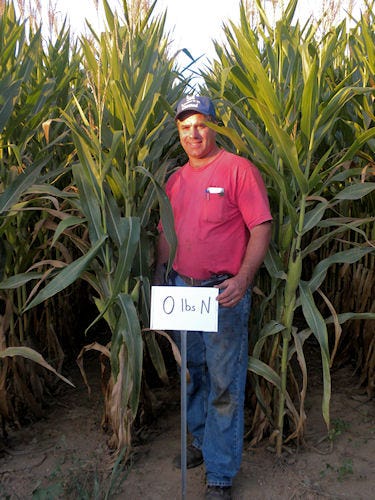December 1, 2011

Steve Groff of Holtwood, Pa., is a Mid-Atlantic Master Farmer and a master of farming. Despite this year's weather challenges, he raised 190-bushel corn in his farm-scale test plots – adding no nitrogen fertilizer.
But before you rush off to try that, consider there's a lot more to what Groff was doing than just cutting off the N spigot. None the less, he's proving that there's more than one way to raise profitable corn.
His Cedar Meadows Farm covers 215 acres in southeast Pennsylvania, just a few miles east and north of where the Susquehanna River empties into the Chesapeake Bay. But there are solid reasons why environmentalists won't worry about run-off from this farm.

MISSION ACCOMPLISHED: With the right growing conditions and healthy soils, Steve Groff produced a 190-bushel test plot corn yield with no nitrogen.
One is that he's been a national leader in developing cover crops for no-till and conventional tillage farming methods. He has worked for more than 10 years with University of Maryland Researcher Ray Weil to develop and bring to market the Tillage Radish cover crop. It's a Daikon variety of the brassica species, selected for its uniquely aggressive single taproot that grows through compacted soils and provides many additional benefits.
Extensive use of nitrogen-fixing cover crops over many years accelerated the build-up of soil organic matter. Beneficial fungi like Mycorrhiza are abundant as are earthworms – signs of healthy soils. A warm growing season may also have helped release more nitrogen from the soil than normal.
Groff attributes that high corn yield to sustained use of no-till practices plus nitrogen-fixing cover crops. Blends of Tillage Radish, legumes like Austrian Winter Peas, and soil-building plants like Phacelia helped replace the need for extra nitrogen.
The corn yield tests were replicated in fields continuously no-tilled for 18 years. The fields were seeded in August 20, 2010 with a 10-species mix of cover crops.
TA Seeds variety TA525-13V (a 103-day) corn was planted April 29, 2011. No nitrogen or starter was applied. Other plots in the fields received 60, 90 and 120 pounds of N as a sidedressing. The harvest was measure by TA Seeds' weigh wagon.
You May Also Like




